Role and fit for dual‐purpose crops for mitigating risk and optimising profit in low rainfall western grain growing regions
Author: Lindsay Bell (CSIRO Toowoomba) | Date: 25 Feb 2016
Take home message
- The flexibility to make use of grazing from grain crops opportunistically can help manage climate and price fluctuations and maximise potential returns across years.
- Long-season dual-purpose cultivars could provide significant biomass for grazing and when well managed potential economic advantages of >$400/ha compared to current grain-only systems.
- Wide sowing window of winter cultivars (e.g. Wedgetail, Revenue) could enable early sowing opportunities to be used without high risk of frost.
- Opportunistic grazing of current spring ‘grain-only’ varieties is possible but they provide less grazing and economic benefits from graze + grain is less ($0-200/ha).
- Under certain price and climatic conditions it might often be more profitable to graze a crop than to continue on to harvest grain.
- Critical yields to sacrificial graze are likely to be most profitable around 1.2-1.5 t/ha, but it is difficult to forecast these situations early in the season based on soil water.
Introduction
Dual-purpose use of grain crops offers the potential to improve the flexibility and resilience of mixed farming systems. Analysis of experimental data has shown that utilising winter cereals (wheat, barley and triticale) and canola for a period of grazing during their vegetative phase before allowing the crop to regrow to produce grain yield (graze + grain), can increase the net returns from that crop by 25-75%. This has been traditionally done with longer-season winter cereals, but research is now showing there is potential to use shorter season spring varieties in the same way. However, they provide less grazing due to the shorter duration of their vegetative phase. In many situations and if grazing is managed correctly, the grazed crop can produce similar grain yields to an ungrazed crop, though it appears that the economic optimum is to graze to a level that incurs a yield penalty of 10-20% compared to an ungrazed crop. In addition to graze + grain uses of cereals there are often situations where sacrificially grazing grain crops with low yield prospects can be more profitable than continuing to harvest grain. Both these opportunities for dual-purpose grazing can provide valuable high quality winter forage, flexibility to use the crop for continued grazing, and hay or silage or grain production. The use of longer-season varieties also widens sowing windows. This paper provides some simulation analysis of the potential fit and productivity of dual-purpose wheat in the lower rainfall districts of northern NSW. It will also examine the potential to tactically graze winter cereal crops and sacrifice grain yield when prospects are poor.
Widening sowing windows
One of the major advantages of winter varieties suited to dual-purpose graze + grain are their capacity to be sown over a wide period and vernalisation controls the timing of flowering to occur at a consistent time of the year. Using historical climate information, an analysis of the frequency of sowing opportunities in fortnightly windows from March to June at Walgett shows that there are often unutilised opportunities during March and April before the opening of the main wheat sowing window. Sowing opportunities are calculated in two different ways here:
1) The first is when the rain received exceeds the potential evaporation over 7 days. This was found to closely correspond with sowing dates for winter crops across Australia and accounts for the fact that more rain is required to trigger a sowing opportunity in March than in May because the evaporation rates are higher.
2) The second is just using a threshold of 15 mm of rain occurring over a 7 day period. This analysis also demonstrates that a sowing opportunity in mid to late May only occurs in 40-50% of years, hence capacity to utilise earlier sowing opportunities on a proportion of the farm to reduce risks of missing later opportunities and reduce pressure on planting machinery availability during the main crop sowing window.
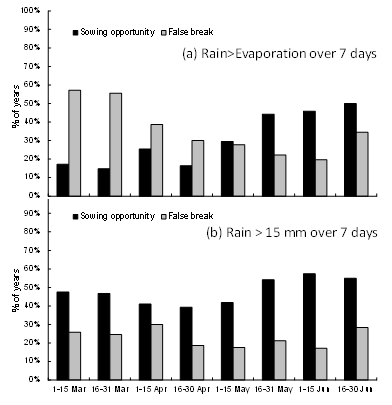
Figure 1. Frequency of a sowing opportunity in fortnightly windows from 1 March to 30 Jun at Walgett. Sowing opportunities were calculated as the % of years when either (a) rainfall exceeded potential evaporation over a 7 day period or (b) when 15 mm of rainfall over a 7 day period.
Potential of graze + grain use of wheat
Figure 2 shows potential grain yields and available biomass for grazing in mid-July from simulations of 3 wheat varieties across a range of possible sowing dates at Walgett. Simulations here assumed the crops were provided with adequate N in the soil throughout the crops growth and a crop was sown on that date irrespective of soil water which had accumulated over a short-fallow following a previous winter crop (average 90-120 mm PAW at sowing).
This shows that the simulated grain yield potentials for a shorter-season winter type variety like Wedgetail is similar to that for a spring wheat like Gregory; median simulated potential grain yields were 3.0-3.5 t/ha. Both varieties are exposed to similar range of variability in grain yields. The predicted yields for a longer-season winter variety like Revenue are lower, due to its later development causing a higher likelihood of water stress during grain filling. Simulations suggest that a well fertilised winter varieties could grow around 5 t DM for grazing by stem elongation. Much less grazing potential could be obtained from spring varieties, 1000-2000 kg of DM for grazing by stem elongation in Gregory.

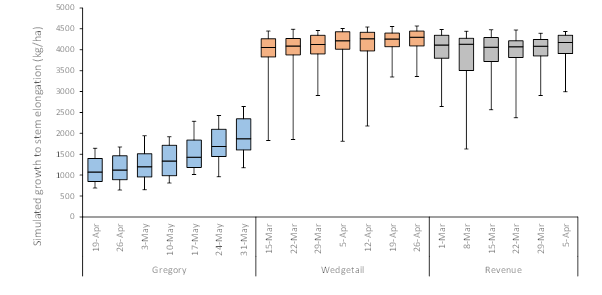
Figure 2. Long-term simulated potential grain yield (top) and biomass available for grazing prior to 15 July (bottom) for Gregory, Wedgetail and Revenue sown on different dates at Walgett.
A simple economic analysis using these simulated grain yields and biomass grown by stem elongation is shown in Figure 3. This analysis assumed a yield penalty of 15% from grazing a crop and a grain price of $270/t, and the biomass growth was converted into livestock returns assuming 20 kg allowance per animal (cattle) per day with a daily live-weight gain of 1.2 kg per day and a price of $1.80/kg LW. The estimated returns were compared to a grain-only Gregory crop sown on 10 May each year. This shows that the potential increase in returns from a graze + grain use of a spring wheat crop is around $50/ha ± $70/ha. Predicted returns are much higher from the longer season wheat crops – the median economic advantage was around $200-450/ha in Wedgetail and $100-380/ha in Revenue. This suggests that even livestock production levels half of those assumed above or yield penalties of >40% would be required before these dual-purpose wheat crops would fall behind the grain only crop.
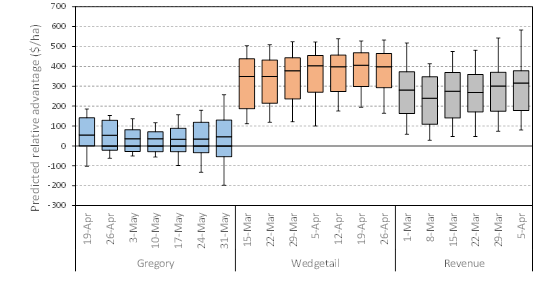
Figure 3. Predicted economic advantage of dual-purpose graze + grain for Gregory, Wedgetail and Revenue sown on different dates at Walgett compared to a Gregory grain only crop sown on 10 May each year. Dual-purpose crop economic assumed a grazing allowance of 20 kg per animal per day, a daily liveweight gain of 1.2 kg per day per animal and a price of $1.8/kg LW and grain yield was reduced by 15%; grain price was assumed to be $270/t.
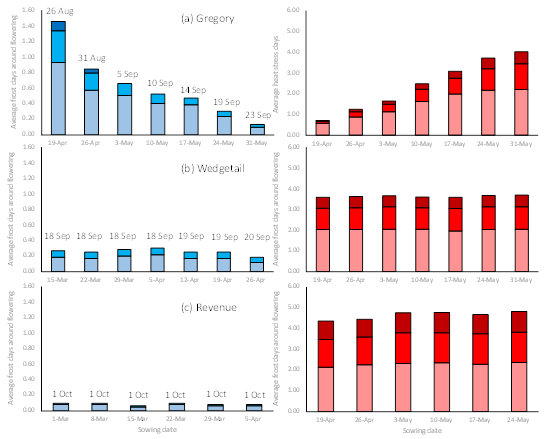
Figure 4. Long-term analysis of average flowering date, and average number of mild (0-+2oC), moderate (-2-0oC), and severe (<-2oC), frost (left) and mild (32-34oC), moderate (34-36oC) and severe (>36oC) heat stress (right) events during flowering and early grain filling for a range of sowing dates for Gregory, Wedgetail and Revenue at Walgett.
The simulations predict potential crop yields and do not take into consideration losses due to frost or heat stress events. Figure 3 shows the likelihood of these events for the different simulated sowing dates for the 3 winter wheat varieties above. This demonstrates the clear difference between the spring and winter varieties in flowering date response to sowing date, with average flowering date in Wedgetail around 18-20 September and Revenue flowering on 1 Oct across all sowing dates. This later flowering of Revenue exposes it to higher risks of high temperature events during flowering. This flowering time for Wedgetail corresponds to a similar flowering date to a crop of Gregory sown in late May. The analysis shows that Gregory sown prior to late April is exposed to increasing risk of frost events. If sowing before this a winter variety like Wedgetail could replace a spring variety in order to avoid high frost risk during flowering.
Tactical sacrificial grazing – is it an option and when?
A further option in addition to grazing grain crops with the plan to lock them up to produce grain is to graze a crop later into the season and sacrifice grain yield. This is likely to be a valuable approach in dry seasons when other forage sources are also in short supply and when grain yields are likely to be low. Here comparisons are made between the amount of biomass produced by a crop at flowering and estimating the potential grazing return from that compared to a crop when only grain is harvested.
Grazing return = Flowering biomass X 50% utilisation X 0.1 kg LW/kg forage consumed x Price
Grain return = Grain yield x Grain price - $35/ha harvesting costs
An analysis across an east-west transect along the NSW/Qld border shows that the frequency that a grain crop has more value for grazing is higher in the drier western locations (e.g. Mungindi) than at Warialda. Soil type can all have a significant influence with soils with lower PAWC likely to run out of water more frequently and hence convert early crop biomass poorly to grain yield (Table 1).
Table 1. Proportion of years when grazing a wheat crop is more profitable than continuing to harvest at 3 locations in northern NSW on soils with different plant available water holding capacity (PAWC). Analysis assumed wheat was sown on the first opportunity each year and a grain price of $270/t and $2.0/kg LW for livestock.
|
Site |
PAWC (mm) |
|||
|
240 |
180 |
120 |
||
|
Mungindi |
0.39 |
0.40 |
0.67 |
|
|
Goondiwindi |
0.23 |
0.23 |
0.44 |
|
|
Warialda |
0.18 |
0.21 |
0.46 |
|
Table 2 examines the effect of soil water at sowing on the likelihood that a crop could have higher value if sacrificially grazed. This shows that crops sown on low levels of soil water will have the highest likelihood of this but crops still sown with higher soil water this is still a frequent occurrence (over 50% of years at Mungundi).
Table 2. Effect of soil water at sowing on frequency that sacrificial grazing is more profitable than harvesting for grain. Analysis assumed a grain price of $270/t and $2.0/kg LW for livestock.
|
PAW at sowing (mm) |
||||||||
|
Location |
0 |
25 |
50 |
75 |
100 |
150 |
200 |
240 |
|
Moree |
75 |
65 |
63 |
55 |
55 |
45 |
35 |
6 |
|
Mungindi |
84 |
67 |
69 |
69 |
67 |
59 |
49 |
6 |
|
Warialda |
65 |
55 |
49 |
45 |
41 |
31 |
27 |
14 |
The relative prices of grain and livestock have a large influence on the likelihood that sacrificially grazing a crop is a more profitable alternative to continuing for grain. Table 3 below shows that if grain prices are > $250 per tonne and livestock prices are below $1.60/kg LW then it is unlikely that grazing a grain crop will achieve greater returns. However, if livestock prices are more attractive then this could be an alternative to consider.
Table 3. Grain & livestock price effects on % of years that a wheat crop is more profitable than harvesting at Mungundi. Grazing calculated using a utilisation of 50% of biomass at flowering and a feed conversion rate of 0.1 kg LW/kg forage consumed.
|
Delivered Grain price ($/t) |
On-farm livestock price ($/kg LW) |
|||
|
1.2 |
1.6 |
2 |
2.4 |
|
|
200 |
13 |
58 |
78 |
88 |
|
250 |
4 |
18 |
55 |
73 |
|
300 |
3 |
4 |
20 |
54 |
|
350 |
3 |
3 |
5 |
20 |
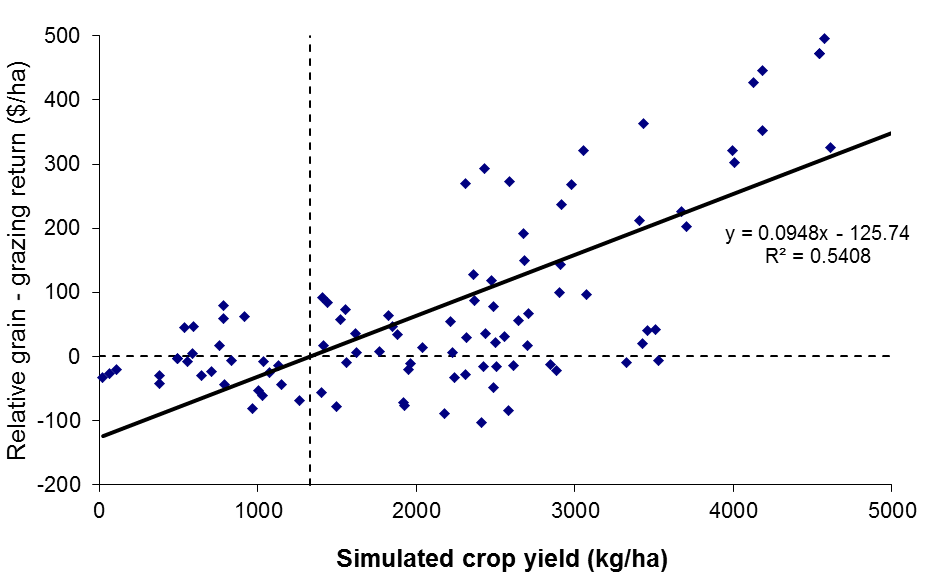
Figure 5. Relationship between final crop yield and relative returns from grain or grazing crop (harvesting grain is more profitable when above the line). This can be used to predict a critical grain yield below which is more profitable to graze a grain crop than continue to harvest.
Challenges of grazing to utilise of dual-purpose crops
One of the greatest potential difficulties for maximising the potential returns from grazing crops, either graze and grain or sacrificial grazing, is the capacity to apply sufficient stocking rates to utilise the forage in the narrow window available. In southern Australia, stocking rates of > 25 DSE or > 8 adult cattle equivalents per ha are used to sufficiently graze rapidly growing cereals. A brief example below I hope will demonstrate the challenge for evenly utilising dual-purpose crops in regions where fields are typically large. Let’s say an early sown wheat crop had 2.5 t DM when you want to start grazing in early June and it is likely to grow at 50 kg of DM/ha/day for the next 6 weeks during which you want to graze it to leave a residual of 1-1.5 t DM/ha (i.e. about 3-3.5 t DM is available for grazing). Assuming an allowance of 2 kg of DM per DSE per day this would require a stocking rate of > 37 DSE/ha over this 6 weeks. So if you had a 50 ha field this would require around 2000 DSE to utilise this forage effectively.
For graze + grain crops, one alternative to the above scenario is to graze at lower stocking rates (<10 DSE/ha) and allow a longer grazing period. This has been applied in the low rainfall wheat-belt of Western Australia where light grazing pressures or ‘clip’ grazing even past crop growth stage 30 (jointing) was shown to have little or no detrimental impact on crop yields compared to ungrazed crops.
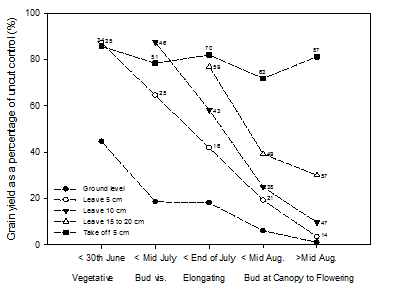
Figure 6. Grain yield recovery of canola crops defoliated at different intensities and timings in the Western Australian wheat-belt (Source: Seymour et al. 2014) showing that light defoliation even later in the season after ‘safe’ lock-up can have only moderate impacts on crop grain yield recovery. Numbers indicate the residual biomass as a % of the control at that time.
Opportunities in other crops
The examples provided above mainly focus on the dual-purpose use of wheat, but there are several other crops where the same principles apply. For graze and grain use there are winter and spring cultivars of canola, barley and triticale which can provide similar benefits to those specified here in wheat. Similarly, several other crops can have multiple uses in a similar way to the sacrificial grazing ideas here. In addition to those species listed above, field pea, soybean, and several millet cultivars could be harvested for grain under favourable seasonal conditions or grazed or harvested for forage if conditions are less suited to grain production.
Contact details
Lindsay Bell
CSIRO
PO Box 102, Toowoomba 4350, Qld
Ph: 07 4688 1221 or 0409 881 988
Email: Lindsay.Bell@csiro.au
Varieties displaying this symbol beside them are protected under the Plant Breeders Rights Act 1994.
GRDC Project Code: CSP000132,
Was this page helpful?
YOUR FEEDBACK
